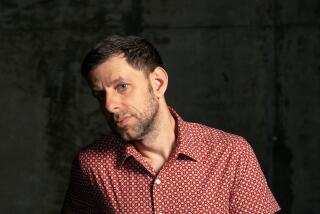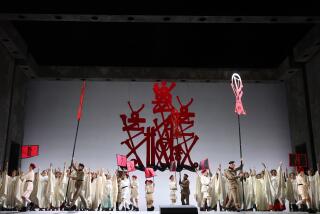OPERA REVIEW : Humperdinck ‘Hansel’ at the Met
- Share via
NEW YORK — To one generation of red-blooded aficionados, Engelbert Humperdinck is some sort of pop celeb with a weirdly usurped name. To unrepentant elderly believers, however, there can be only one Humperdinck: the inspired Wagner acolyte who in 1893 wrote “Hansel and Gretel,” the opera.
It is a wonderful opera and, in many ways, a strange opera. On one hand, it is a simple fairy tale for the kiddy crowd involving a couple of hungry but quaint and mellifluous urchins, a comic-nasty witch, 14 greeting-card angels and the inevitable triumph of innocence over evil. On the other hand, it is a big, broad and spacious music drama for adults, replete with sophisticated motivic references, heroic affect, pious Bayreuth manners and a full “Meistersinger” orchestra.
Saturday night, the Metropolitan Opera tried for the 168th time to bridge the gap between charming naivete and swollen rhetoric. The results were a bit uneven, as usual, but the family crowd seemed happy.
This was, incidentally, a happy family crowd that failed to fill every seat in the 4,000-seat house. Since the top ticket cost $98, that cannot be too surprising.
The current production of “Hansel” may have seen better days, but it remains eminently, chronically picturesque. It dates back to 1967, a time when directors were just beginning to explore the joys of toying with the newfangled stage machinery at Lincoln Center.
The angels fly like Peter Pan. So does the witch. Magical transformations take place before our wondering eyes. Rosina Dainty-mouth’s candy castle somehow arises in the mist from the bowels of the New York subway system.
Whoopee.
Nathaniel Merrill, the stage director, and Robert O’Hearn, the designer, embellished the drama with a hoard of diminutive extras impersonating extraneous flora and fauna. The oh-so-adorable little critters look like rejects from some provincial production of “The Cunning Little Vixen.” Most observers, however, find them cute, cute, cute.
In general, Merrill and O’Hearn have paid Humperdinck the compliment of playing the opera straight. They make no apologies for the goo. They go about their cloying business with unswerving seriousness of purpose. It must be the only way.
Christof Perick, the current conductor, wisely stresses lyricism rather than bombast in the pit. Unfortunately, the vaunted Met orchestra played rather scrappily for him on this occasion.
The cast was dominated, for once, by the witch. Although Gustav Mahler cast the formidable Ernestine Schumann-Heink in the role for the Hamburg premiere, the role is usually assigned these days to croaking comprimarios--sometimes even to a croaking comprimario in drag. Janis Martin, who has sung Brunnhilde in Munich and Elektra in San Francisco, whooped and swooped through the challenge with full-throated Wagnerian splendor. What’s more, she enacted the nasty charades with gleeful good humor, tinged with a hint of operatic self-mockery. She was lovely.
The protagonists seemed a bit timid in context. Frederica von Stade was gangly, gawky and tastefully restrained as a bel-canto Hansel. Judith Blegen played Gretel as a wide-eyed wind-up doll and, when audible, chirped deftly.
The parents proved less than ideally matched. Timothy Noble exuded baritonal bravado as the father, and articulated Norman Kelley’s clever English translation with enough point to make any thoughts of supertitles irrelevant. Marita Napier exuded sympathy as the mother, but mangled the text in a manner that makes one long for those infernal supertitles.
The soprano spirits were nicely delineated. Margaret Jane Wray introduced a jolly, bearded Sandman equipped with a bona fide Aida voice. Sweet Betsy Norden glided wispily through the measures of the Dew Fairy while dutifully bathing the stage in glitter dust.
It was a pretty good night for luxurious, old-fashioned, unabashed kitsch.
More to Read
The biggest entertainment stories
Get our big stories about Hollywood, film, television, music, arts, culture and more right in your inbox as soon as they publish.
You may occasionally receive promotional content from the Los Angeles Times.










